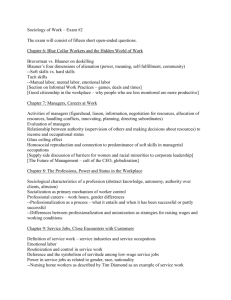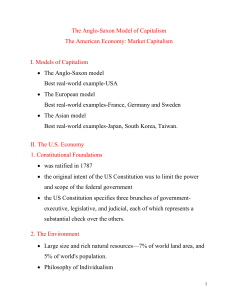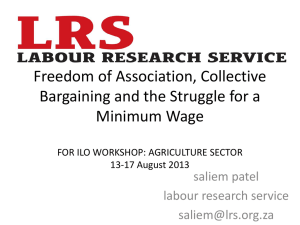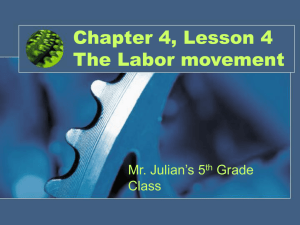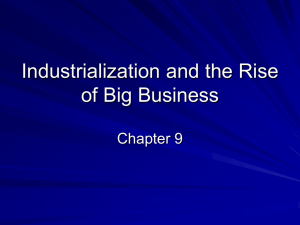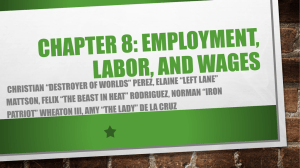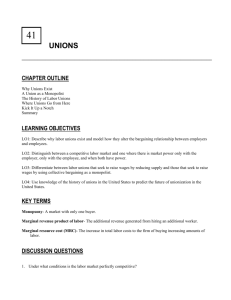Chapter 9 notes
advertisement
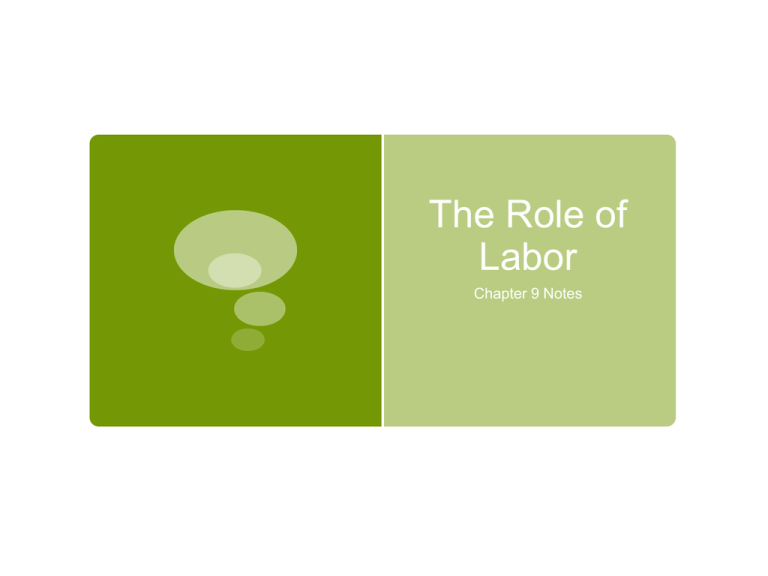
The Role of Labor Chapter 9 Notes How are wages determined? Section 1 The price of Labor is Wages – the payments workers receive in return for work Governed by the forces of supply and demand. Equilibrium wage – the wages at which the quantity of workers demanded equals the quantity of workers supplied; the market price for labor Demand for Labor A business hires workers to help it produce goods or provide a service. A producers demand for labor is therefore a Derived demand – a demand for a product or resource based on its contribution to the final product. Workers with higher productivity earn higher wages. Demand and Supply Curves for Labor Demand for labor is like any other product – when price goes up, quantity demanded goes down. Supply of Labor More workers are willing to work at higher wages than lower wages. Equilibrium Wage – is reached just like it is with the price of other products Why do wage rates differ? Different jobs have different Wage rates – the established rate of pay for a specific job or work performed. Wage rates are determined by supply and demand, which in turn are influenced by four key factors: 1 - Human capital – the knowledge and skills that enable workers to be productive; 2 working conditions; 3 – discrimination in the workplace; 4 – government actions. 1 - Human Capital – Economist group workers by the amount of human capital they have. Unskilled Workers – house cleaners, sanitation workers SemiSkilled workers – construction workers, clerical workers Skilled Workers – plumbers and electricians – specialized training Professional Workers – doctors, lawyers – intensive professional training – the highest human capital The demand for higher skilled workers is high and therefore they can demand higher salaries. The prospect of higher wages leads many people to invest in their human capital, and enroll in vocational education, specialist training, and higher education. 2 – Working Conditions Higher wages are often paid to workers in dangerous and unpleasant occupations in order to attract qualified people to those jobs. The advantages of some jobs make up for lower wages. 3 – Discrimination Wage discrimination may be based on may be based on race, ethnicity, or other factors. Women on average make less than men. Prejudice. Employers may miss out on the best employees if they discriminate. Occupational segregation – some low-paying jobs come to be seen as belonging to the realm of women or certain minorities; groups can become trapped in these jobs, unable to earn enough to invest in human capital to move them upward. Antidiscrimination laws - Equal Pay Act (1963), Civil Rights Act (1964) Glass ceiling – an unseen, artificial barrier to advancement that women and minorities sometimes face 4 – Government Actions The government steps in when market forces produce results people disagree with. Minimum wage – the lowest amount, established by law, that an employer may pay a worker for one hour of work. Market forces may set a wage too low for anyone to make a living doing a particular job. Some states and localities have set minimum wages higher that the federal minimum wage. Trends in Today’s Labor Market Section 2 In the 1950’s companies hired workers with the expectation that they would work for the same company for their entire lives and be provided with a pension for their retirement. Today, few workers will work for the same company for their entire careers and workers must take responsibility for their own retirement. Civilian labor force – people aged 16 or older who are employed or actively looking for and available for work 2005 – 150, 000,000 Americans 2020 – 165, 000,000 Changes in the U.S. Labor Force More women in the labor force since the 50’s. The kinds of jobs open to women have expanded. Wages for women have risen. Better educated. 30% have college degrees, 30% have some college. Changing Occupations Three sectors of occupations: Primary Sector – jobs related to natural resources – farming, forestry, fishing, mining; Secondary Sector – jobs related to production of goods including the materials and energy needed to produce them- welders, construction, truck drivers Tertiary sector – service related jobs – banking, insurance, retail, education, communications Manufacturing jobs in the US have declined since the 1950’s and service sector jobs have increased. Technology and Change Technology has eliminated or redefined many jobs in all three occupational sectors. About half of all Americans use a computer on the job. Those occupations that support computers, data, networking have increased. Globalization and Jobs Technology allows companies to employ people all over the world. Outsourcing – the practice of contracting with an outside company, often in a foreign country, to provide goods or services; saves money. Many companies add more jobs in the US than they outsource overseas. The US economy also benefits from Insourcing – the foreign companies establishing operations in, and therefore bringing jobs to, the United States. Changes in the way people work Telecommuting – the practice of doing office work in a location other than the office Companies have fewer permanent positions and have more Contingent employment – temporary or part-time work. Many people work as Independent contractors – someone who sells his or her services on a contract basis. Today, most people will change careers several times as the world of work continues to evolve. Working at the office from Home. Reduced stress; flexibility in work time; avoiding the commute to work. Expanded labor pool, increased productivity, lower real estate cost. Fewer commuters, less pollution. Telecommuting grew by 20% each year from 2000 to 2005. Alternatives to Permanent Employment Hiring contingent workers make it easier for a business to adjust their workforce. Discharging temporary workers is easier than fulltime employees. Most temporary worker don’t receive benefits, so they cost less. Many workers enjoy being their own boss as contract workers. Sometimes permanent positions are offered to temporary workers who do a good job. Changing Careers More Often Much of the work done in the US and other advanced counties did not exist 100 years ago. Technology creates new jobs and makes some jobs obsolete. Workers must learn and adapt to new technology. Change in the economy is constant and rapid. Organized Labor in the United States Section 3 Labor Movement’s Rise to Power Organized labor helped shape the modern workplace. Eight-hour work day, five-day work week, vacations, sick leave Labor union – an organization of workers that seeks to improve wages, working conditions, fringe benefits, job security, and other work-related matters for its members. Unions negotiate with businesses to achieve their goals. To demonstrate their power they will turn to a Strike – a work stoppage used to gain negotiating power while attempting to convince an employer to improve wages, working conditions, or other workrelated matters. Craft unions – Industrial unions – Early Developments First national federation – National Trade Union 1834, ended 1837. 1869 Knights of Labor – organized by industry, not trade or skill level, During industrialization, employers resisted the efforts of workers to organize; violence. 1886 - Haymarket Square bombing and riot. Police and protestors killed and wounded. 1892 – 10 workers killed in a strike against Carnegie steel in Homestead, Penn. 1894 – Pullman Palace Railway strike; National Guard troops brought in to keep the nations railways moving; violence. 1886 – Samuel Gompers – founded the American Federation of Labor (AFL); economic empowerment for workers and backed pro-union candidates. Unions Gain Power Labor legislation passed as part of the New Deal 1932 – Norris-LaGuardia Act – outlawed the practice of only hiring workers that agreed to not join unions. It required employers to allow workers to organized with out interference 1935 – National Labor Relations Act – protected the rights of workers in the private sector to form unions and use strikes. 1938 – Fair Labor Standards Act – set a minimum wage, required extra pay for overtime work, made most child labor illegal. The Labor Movement’s Steady Decline Backlash Against Unions Following WWII Fear of Communism lead to further restrictions on unions. Union membership has fallen to about 12.5 % in 2005. The decline of unions can be traced to union’s tarnished reputations, changes in the labor force, and laws restricting union membership. Loss of Reputation Prolonged strikes lead to disruption of the public and placed a burden on striking families. Increasing costs; ties to organized crime. Labor Force Changes Union membership has usually been linked to manufacturing jobs. As the number of manufacturing jobs has decreased, so has union membership. Temporary and contingent workers are not usually union members either. SEIU has focused on recruiting service workers like janitors and caregivers. Right-to-Work Laws Some legislation tries to limit union membership Closed shop – a business in which and employer can hire only union members Union shop – a business in which workers are required to join a union within a set period of time after being hired The Taft-Hartley Act outlawed the closed shop and weakened the possibilities of the union shop. Some states have passed Right-to-work laws – legislation that makes it illegal to require workers to join unions. Union Negotiating Methods Collective bargaining – the process of negotiation between a business and its organized employees to establish wages and improve working conditions. Unions wield more negotiating power than an individual worker. Binding arbitration – a process by which an impartial third party resolves disputes between management and unions For industries related to public safety, the government may get involved to halt a work stoppage if it feels that protest activities may interfere with public safety.
